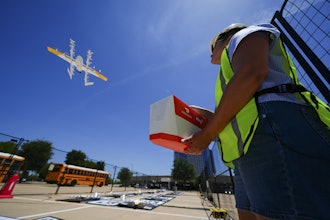This article first appeared in IMPO's August 2013 issue.
New features in pallets and racking, including better material composition, more secure racks, and better accessibility are making today’s industrial pallet and racking solutions safer and more cost effective than ever before. In this ever changing world of material handling, manufacturers are doing everything they can to choose wisely, stay efficient, and incorporate safety.
Popular And Versatile
“Pallet rack is the most popular and versatile type of storage rack, providing immediate accessibility to every pallet load,” says Jeff Woroniecki, executive vice president of business development and operations with the Material Handling Institute (MHI). “There are many styles and types of racking systems to choose from.” The optimum racking system depends on the types of operations it will be supporting, typically driven by inventory turns and type of product stored, and “each has its own benefits depending on the needs of the facility.
“Selective pallet racks are probably the most commonly used system,” he says. Featuring pallets that are accessible from the structure’s aisle, this system is typically associated with narrow aisle racking, standard, and deep reach systems.
Pallet flow, drive-in, and drive-through racks are capable of high density storage and are “the best storage option for perishable items where a first-in, first-out (FIFO) inventory system is critical,” Woroniecki explains.
For industries that don’t have shelf life to contend with, but high density storage is required, drive-in racking systems are ideal, still allowing for high capacity storage. “Items stored in drive-in racks are typically loaded via the last-in, first-out (LIFO) process,” Woroniecki says. “Due to this method, drive-in systems are suitable for nonperishable products and items with a low turnover, as storage is not readily accessible.”
Facilities looking for bulk storage may turn to push back racking systems, which are capable of storing products that run several pallets deep and several lengths high. “When a pallet is placed or loaded on the structure, it ‘pushes’ the next pallet back on the rails where it rests,” Woroniecki explains. “When the pallets are unloaded from the rails, they are pushed to the front of the structure.” These structures are also loaded using the LIFO system, and are considered ideal for large storage systems.
“A few essential factors should be considered when selecting a pallet rack system,” he adds. “The cost of materials, space, and height available; types of storage items; and inventory that will be stored should be assessed. The Rack Manufacturers Institute (RMI) offers many resources and information on leading racking manufacturers to aid in this process.”
Safety First
Part of choosing a successful pallet and racking solution is also considering safety, and there has been an increased focus on this area in recent years, says Dave Olson, P.E., president of RMI and national sales and marketing manager of Ridg-U-Rak. In 2012, RMI issued a new safety guideline that addresses many of the issues related to proper design and planning and safe use of storage rack systems. The institute is currently working on a new guideline, he adds, “specifically focused on the assessment and repair of damaged rack systems.”
Racking safety currently in use in the industry includes things like piston safety locks — a “new kind of safety pin attaching end connectors to uprights, that snaps into place with an audible click, ensuring the user that the end connector is properly installed,” explains Interlake Mecalux’s Greg Hajdus, director of technical training.
And the recent increase in natural disasters has raised safety awareness and created “more intense focus on the design, installation, maintenance, and increased safety of racking structures,” says Woroniecki. For example, today’s rack structures can be seismically designed for earthquakes forces and feature stronger beam-to-beam connections, additional anchorage requirements, and stronger columns. “These additional design requirements also improve safety in industrial environments where a racking system is often struck by a fork truck or other industrial equipment,” he adds.
“While we are not yet where we need to be, there are significant strides being made in regards to storage rack safety,” says Olson.
Hybrid, Plastic Solutions
“Pallet racks are primarily made from either hot rolled structural steel or cold formed sheet steel. However, in the past five to seven years, hybrid rack designs have become more common,” says Woroniecki. Hybrid rack design combines the ruggedness of structural frames and the flexibility and efficiency of roll formed beams, he explains, which can be a cost saver because steel is located in the areas of the hybrid system where damage is more likely. “The structure is rugged enough to withstand the toughest industrial environments where impact resistance is demanded, while providing the necessary flexibility of an engineered rack system.”
Thermoformed plastics present another option for manufacturers looking for energy and economic benefits. Thermoforming can generate large plastic parts at a lower overall cost than steel, aluminum, or fiberglass reinforced plastics and provides corrosion resistance, as well as high impact capabilities. Thermoformed plastic pallets also provide some environment benefits, though not without roadblocks, says Louis Smith, president of SAY Plastics. The natural benefit to the environment of these thermoformed pallets, he says, is the option to keep them out of a landfill. The materials can be ground into “utility” sheet product, but need to be degreased and washed before grinding the forms. “Companies struggle to include the disposal costs at the end of the cycle and always look back to the original vendor to support the recycling efforts,” Smith says. Oftentimes, these suppliers don’t have the ability to clean/degrease the products, forcing this expense onto “responsible organizations that see the process through,” he adds. “It is not difficult to do, but must be managed properly.”
A Supported System
“A custom designed material handling system is only successful when all of the stakeholders have complete buy-in to the system,” Smith says, “that means the end manufacturer, the supplier or vendor, the freight company, and any other entity that has a responsibility to the application.” These systems can be a blend of metal, plastic components, vinyl, foams, and a variety of other components, and are no small system to put together. Manufacturers looking to invest in, or improve upon, their pallet and racking don’t need to do it alone. A number of vendors are available to their customer during the purchasing and beyond.
“We can provide stamped drawing and final seismic calculations, installation services, freight, and any outside purchases such as wire decking, floor decking, and safety netting,” explains Hajdus. “We also offer training to educate users on their new products, how we develop them, and all that they are capable of.”
Doing More
“Selecting the best rack for an installation can reduce manual processes,” says Hajdus. “This decreases time spent moving the items, which in turn shrinks the window for accidents and product damage. Overall, the right rack will reduce product damage, speed picking times, facilitate the distribution process, and save time and money.
“The right rack does not simply store product.”
Palletizing Robots
Robotic palletizers utilize vacuum or advanced servo-mechanical grippers to handle a variety of packaging formats, while providing reliable speed and pallet handling. John Barry, vice president of sales and marketing, ITWWA Americas discusses some common questions surrounding this high-tech material handling option.
Q: What can a robotic palletizer do?
Robotic palletizers can handle multiple SKUs in a single pass. They also provide gentle product handling — moving lightweight primary and secondary containers with ease and reducing product damage. Pallet pattern building is also easier and more dynamic. Users no longer need an OEM operator to program new patterns. The palletizers are overall more intuitive with an infinite number of flips and patterns. Robotic palletizers offer greater accuracy, reduce product damage, and offer easier maintenance due to fewer moving parts. They also enable one to palletize offset packaging.
Q: When should a facility look to automated palletizing?
- 1. When looking to reduce labor or minimize employee injury from heavy lifting and repetitive motion.
- 2. As SKUs or volume increase.
- 3. To reduce product damage.
- 4. To standardize pallet building.
Q: How can industrial users find the right robotic palletizer to meet their needs?
It’s important to determine primary needs: speed, product type, volume, and space constraints. Budget is also an important factor to consider when choosing the right robotic palletizer. Look at both short and long term needs and potential ROI of the palletizer. Also, consider the company growth and look for scalable robotic palletizer that will serve immediate and future needs.























